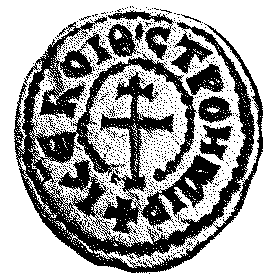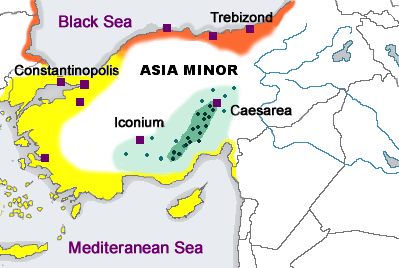|
Sermon (ruler)
Sermon ( el, Σέρμων; Bulgarian and Serbian Cyrillic: Сермон) was an early 11th-century voivode (duke) of Syrmia and a local governor in the First Bulgarian Empire, vassal of Bulgarian emperor Samuil. His residence was in Sirmium (today Sremska Mitrovica, Serbia). He was described in Byzantine sources as: "''ruler of Syrmia and brother of Nestongos''" ( el, ὁ τοῦ Σιρμίου κρατῶν ἀδελφὸς τοῦ Νεστόγγου). Identity and history Very little is known about him. Even his name may be simply a corruption of the name of Sirmium, added in the text of John Skylitzes in a later commentary. He had a brother, Nestongos, about whom nothing further is known, but who may have been an ancestor of the Nestongos aristocratic family that appears in Byzantium in the 11th–14th centuries. Following the death of the Bulgarian Tsar Ivan Vladislav in early 1018, Bulgarian resistance against the Byzantine emperor Basil II collapsed. Basil therefore ... [...More Info...] [...Related Items...] OR: [Wikipedia] [Google] [Baidu] |
Ahtum Sermon03 01
Ajtony, Ahtum or Achtum ( hu, Ajtony, bg, Охтум, ro, Ahtum, sr, Ахтум) was an early-11th-century ruler in the territory now known as Banat in present Romania and Serbia. His primary source is the ''Long Life of Saint Gerard'', a 14th-century hagiography. Ajtony was a powerful ruler who owned many horses, cattle and sheep and was baptised according to the Orthodox rite in Vidin. He taxed salt which was transferred to King Stephen I of Hungary on the Mureș River. The king sent Csanád, Ajtony's former commander-in-chief, against him at the head of a large army. Csanád defeated and killed Ajtony, occupying his realm. In the territory, at least one county and a Roman Catholic diocese were established. Historians disagree on the year of Ajtony's defeat; it may have occurred in 1002, 1008 or between 1027 and 1030. His ethnicity is also a subject of historical debate; he may have been Hungarian, Kabar, Pecheneg or Romanian. In Romanian historiography Ajtony is viewed as ... [...More Info...] [...Related Items...] OR: [Wikipedia] [Google] [Baidu] |
Balkans
The Balkans ( ), also known as the Balkan Peninsula, is a geographical area in southeastern Europe with various geographical and historical definitions. The region takes its name from the Balkan Mountains that stretch throughout the whole of Bulgaria. The Balkan Peninsula is bordered by the Adriatic Sea in the northwest, the Ionian Sea in the southwest, the Aegean Sea in the south, the Turkish Straits in the east, and the Black Sea in the northeast. The northern border of the peninsula is variously defined. The highest point of the Balkans is Mount Musala, , in the Rila mountain range, Bulgaria. The concept of the Balkan Peninsula was created by the German geographer August Zeune in 1808, who mistakenly considered the Balkan Mountains the dominant mountain system of Southeast Europe spanning from the Adriatic Sea to the Black Sea. The term ''Balkan Peninsula'' was a synonym for Rumelia in the 19th century, the European provinces of the Ottoman Empire. It had a geop ... [...More Info...] [...Related Items...] OR: [Wikipedia] [Google] [Baidu] |
Syrmia (theme)
The Theme of Sirmium ( el, θέμα Σιρμίου) was a Byzantine administrative unit (theme), which existed in present-day Serbia, Croatia and Bosnia and Herzegovina in the 11th century. Its capital was Sirmium (today Sremska Mitrovica). Background In the 6th century, another Byzantine province existed in this area. It was known as Pannonia and also had its capital in Sirmium, but was much smaller in size. In the beginning of the 11th century, the area which later became the Theme of Sirmium lay within the borders of the First Bulgarian Empire, under Tsar Samuil and the local duke (voivode) known as Sermon ruled over Sirmium and surrounding area. In a long war, the Byzantine emperor Basil II conquered Bulgaria, and established new Byzantine themes and other local governorates under generals (''strategoi'') on its territory. The central part of Samuil's realm became the Theme of Bulgaria, the northeastern part the Theme of Paristrion, and the northwestern part became the Theme ... [...More Info...] [...Related Items...] OR: [Wikipedia] [Google] [Baidu] |
Rulers Of Vojvodina
This is a list of local rulers of Vojvodina. The list also include local rulers of Banat, Bačka and Srem, including parts of mentioned regions, which are not part of present-day Vojvodina, as well as other rulers of larger political units that had specific local ties to territory of present-day Vojvodina. Ancient times Roman emperors * Maximinus, Roman emperor (235–238), ruled from residence in Sirmium * Decius Traian, Roman emperor (249–251), born in village Budalia near Sirmium *Ingenuus, Roman emperor (260), proclaimed himself emperor in Sirmium *Regalianus, Roman emperor (260), proclaimed himself emperor in Sirmium *Claudius II, Roman emperor (268–270), spent most of his life in Sirmium *Aurelian, Roman emperor (270–275), born in Sirmium * Probus, Roman emperor (276–282), born in Sirmium *Maximianus Herculius, Roman emperor (285–310), born near Sirmium *Galerius, Roman emperor (305–311), ruled as Caesar during the Tetrarchy from residence in Sirmium (293–296 ... [...More Info...] [...Related Items...] OR: [Wikipedia] [Google] [Baidu] |
History Of Vojvodina
Vojvodina ( Serbian: Војводина or ''Vojvodina''; hu, Vajdaság; sk, Vojvodina; ro, Voivodina; hr, Vojvodina; Rusyn: Войводина) is an autonomous province that comprises northern Serbia. It consists of the southern part of the Pannonian Plain, mostly located north from the Danube and Sava rivers (part of the Mačva region that belongs to Vojvodina is located south of Sava). Name The name ''"Vojvodina"'' (Војводина) in the Serbian language simply means "voivodship" or " duchy". Its original historical name from 1848 was " Serbian Voivodship" (Serbian Vojvodina). The Serbian language uses two more varieties of the word ''Vojvodina''. These varieties are ''Vojvodovina'' (Војводовина), and ''Vojvodstvo'' (Војводство), the latter being an equivalent to the Polish word for province, ''województwo'' (voivodship). As for the names of the three historical and geographical regions of which Vojvodina is composed, Syrmia was named after th ... [...More Info...] [...Related Items...] OR: [Wikipedia] [Google] [Baidu] |
History Of Syrmia
Syrmia ( sh, Srem/Срем or sh, Srijem/Сријем, label=none) is a region of the southern Pannonian Plain, which lies between the Danube and Sava rivers. It is divided between Serbia and Croatia. Most of the region is flat, with the exception of the low Fruška gora mountain stretching along the Danube in its northern part. Etymology The word "Syrmia" is derived from the ancient city of Sirmium (now Sremska Mitrovica). Sirmium was a Celtic or Illyrian town founded in the third century BC. ''Srem'' ( sr-cyr, Срем) and ''Srijem'' are used to designate the region in Serbia and Croatia respectively. Other names for the region include: * Latin: ''Syrmia'' or ''Sirmium'' * Hungarian: ''Szerémség'', ''Szerém'', or ''Szerémország'' * German: ''Syrmien'' * Slovak: ''Sriem'' * Rusyn: Срим * Romanian: ''Sirmia'' History Prehistory Between 3000 BC and 2400 BC, Syrmia was at the centre of Indo-European Vučedol culture. Roman era Sirmium was conquer ... [...More Info...] [...Related Items...] OR: [Wikipedia] [Google] [Baidu] |
History Of Serbia
The history of Serbia covers the historical development of Serbia and of its predecessor states, from the Early Stone Age to the present state, as well as that of the Serbian people and of the areas they ruled historically. Serbian habitation and rule has varied much through the ages, and as a result the history of Serbia is similarly elastic in what it includes. Serbs settled the Balkans in the 6th and 7th centuries, with the most prominent settlement being the First Serbian Principality of the Vlastimirovići dynasty ruling over modern-day Montenegro, Bosnia, Dalmatia, Serbia. It evolved into a Grand Principality by the 11th century, and in 1217 the Kingdom and national church ( Serbian Orthodox Church) were established, under the Nemanjići dynasty. In 1345 the Serbian Empire was established, spanning most of the Balkan peninsula. In 1540 Serbia became a part of the Ottoman Empire. A significant number of Serbs migrated north, to the Kingdom of Hungary forming what ... [...More Info...] [...Related Items...] OR: [Wikipedia] [Google] [Baidu] |
Medieval Greek
Medieval Greek (also known as Middle Greek, Byzantine Greek, or Romaic) is the stage of the Greek language between the end of classical antiquity in the 5th–6th centuries and the end of the Middle Ages, conventionally dated to the Ottoman conquest of Constantinople in 1453. From the 7th century onwards, Greek was the only language of administration and government in the Byzantine Empire. This stage of language is thus described as Byzantine Greek. The study of the Medieval Greek language and literature is a branch of Byzantine studies, the study of the history and culture of the Byzantine Empire. The beginning of Medieval Greek is occasionally dated back to as early as the 4th century, either to 330 AD, when the political centre of the Roman Empire was moved to Constantinople, or to 395 AD, the division of the empire. However, this approach is rather arbitrary as it is more an assumption of political, as opposed to cultural and linguistic, developments. Indeed, by this time ... [...More Info...] [...Related Items...] OR: [Wikipedia] [Google] [Baidu] |
Petrovaradin
Petrovaradin ( sr-cyr, Петроварадин, ) is a historic town in the Serbian province of Vojvodina, now a part of the city of Novi Sad. As of 2011, the urban area has 14,810 inhabitants. Lying on the right bank of the Danube, across from the main part of Novi Sad, it is built around the Petrovaradin Fortress, historical anchor of the modern city. Name Petrovaradin was founded by the Celts, but its original name is unknown. During Roman administration it was known as ''Cusum''. After the Romans conquered the region from the Celtic tribe of Scordisci, they built the Cusum fortress where present Petrovaradin Fortress now stands. In addition, the town received its name from the Byzantines, who called it ''Petrikon or Petrikov (Πετρικον)'' and who presumably named it after Saint Peter. In documents from 1237, the town was first mentioned under the name ''Peturwarod'' (''Pétervárad''), which was named after Hungarian lord Peter, son of Töre. Petrovaradin was know ... [...More Info...] [...Related Items...] OR: [Wikipedia] [Google] [Baidu] |
Novi Sad
Novi Sad ( sr-Cyrl, Нови Сад, ; hu, Újvidék, ; german: Neusatz; see below for other names) is the second largest city in Serbia and the capital of the autonomous province of Vojvodina. It is located in the southern portion of the Pannonian Plain on the border of the Bačka and Syrmia geographical regions. Lying on the banks of the Danube river, the city faces the northern slopes of Fruška Gora. , Novi Sad proper has a population of 231,798 while its urban area (including the adjacent settlements of Petrovaradin and Sremska Kamenica) comprises 277,522 inhabitants. The population of the administrative area of the city totals 341,625 people. Novi Sad was founded in 1694 when Serb merchants formed a colony across the Danube from the Petrovaradin Fortress, a strategic Habsburg military post. In subsequent centuries, it became an important trading, manufacturing and cultural centre, and has historically been dubbed ''the Serbian Athens''. The city was heavily dev ... [...More Info...] [...Related Items...] OR: [Wikipedia] [Google] [Baidu] |
Constantinople
la, Constantinopolis ota, قسطنطينيه , alternate_name = Byzantion (earlier Greek name), Nova Roma ("New Rome"), Miklagard/Miklagarth ( Old Norse), Tsargrad ( Slavic), Qustantiniya (Arabic), Basileuousa ("Queen of Cities"), Megalopolis ("the Great City"), Πόλις ("the City"), Kostantiniyye or Konstantinopolis (Turkish) , image = Byzantine Constantinople-en.png , alt = , caption = Map of Constantinople in the Byzantine period, corresponding to the modern-day Fatih district of Istanbul , map_type = Istanbul#Turkey Marmara#Turkey , map_alt = A map of Byzantine Istanbul. , map_size = 275 , map_caption = Constantinople was founded on the former site of the Greek colony of Byzantion, which today is known as Istanbul in Turkey. , coordinates = , location = Fatih, İstanbul, Turkey , region = Marmara Region , type = Imperial city , part_of = , length = , width ... [...More Info...] [...Related Items...] OR: [Wikipedia] [Google] [Baidu] |





.jpg)
